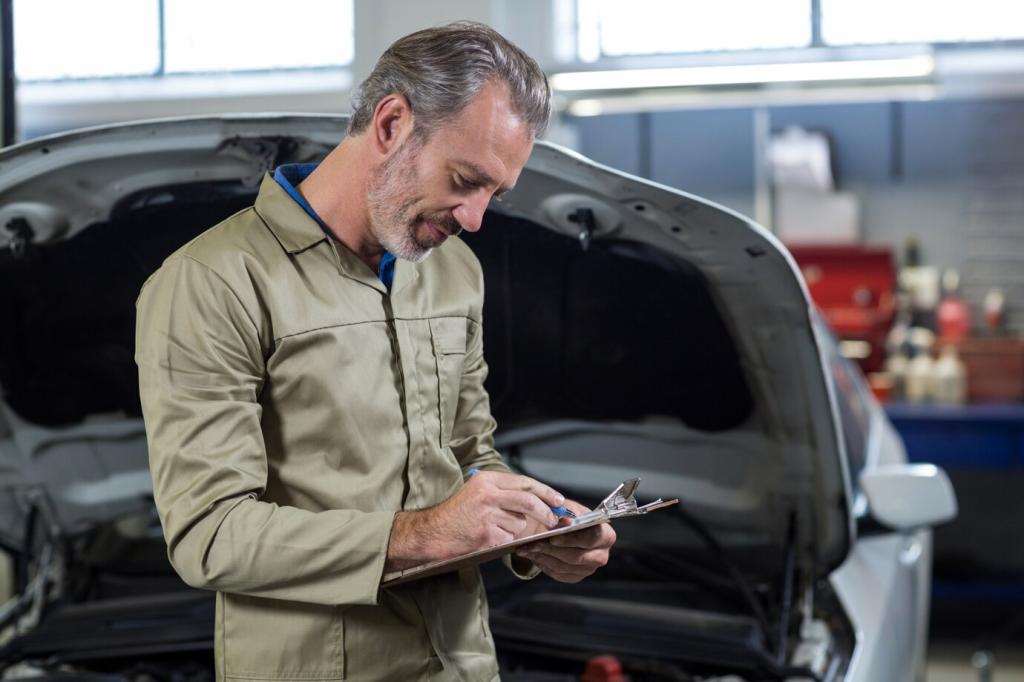DIY Brake Maintenance and Repair: Take Control of Your Stopping Power
How Your Brakes Actually Work
Pressing the pedal pressurizes fluid in the master cylinder, sending force through lines to calipers. Pistons push pads against spinning rotors, converting motion to heat. No magic, just physics. Comment with questions about master cylinder behavior or soft pedal issues you’ve experienced.
How Your Brakes Actually Work
Pads grip rotors using carefully engineered friction compounds. Excess heat reduces friction, causing fade that lengthens stopping distances. Choosing the right pad and ensuring clean rotor surfaces reduces squeal and improves feel. Share your pad choices and how they performed on daily commutes or mountain drives.
Safety, Workspace, and Tools
A solid jack, quality jack stands, torque wrench, breaker bar, C-clamp or piston compressor, wire brush, brake cleaner, and hex or Torx bits cover most jobs. Keep rags handy. Share what tools saved your weekend when a stubborn bolt refused to move.

Smart Diagnostics Before You Wrench
High-pitched squeal often points to wear indicators or glazing. Grinding suggests metal-to-metal and urgent pad replacement. Low groans can mean contamination or hardware wear. Record a short clip of your noise during a safe test and ask us to help decode it.


Smart Diagnostics Before You Wrench
A spongy pedal hints at air in lines or old fluid. A hard pedal can mean vacuum assist issues. A sinking pedal raises master cylinder concerns. Describe when the symptom appears—engine on, off, or after repeated stops—to narrow the cause.
Pads and Rotors: A Clean Replacement Process
Support the caliper with wire, never by the hose. Loosen guide bolts, lift the caliper, and retract pistons slowly to avoid pushing dirty fluid backward too quickly. Tell us if your reservoir threatened to overflow and how you managed it cleanly.
Clean rotor faces with brake cleaner to remove oils. Check hub rust with a wire brush to minimize runout. After installation, bed pads with controlled stops to transfer an even layer. Post your bedding routine and whether it eliminated initial squeaks.
Replace pad hardware, lubricate slide points lightly with high-temperature brake grease, and torque bolts to spec. Over-greasing attracts dust, under-greasing binds slides. Share torque spec sources for your model and favorite techniques to keep pads moving freely.


This is the heading
Lorem ipsum dolor sit amet, consectetur adipiscing elit. Ut elit tellus, luctus nec ullamcorper mattis, pulvinar dapibus leo.

This is the heading
Lorem ipsum dolor sit amet, consectetur adipiscing elit. Ut elit tellus, luctus nec ullamcorper mattis, pulvinar dapibus leo.
Drum-in-Hat Parking Brake Adjustment
Many rear rotors hide parking brake shoes inside. With the rotor off, inspect linings, springs, and adjusters. Fine-tune clearance so shoes lightly drag when spun by hand. Tell us how many clicks your lever or switch now takes to hold steady.
Cable Inspection and Lubrication
Check for frayed strands, sticky sheaths, and uneven tension side to side. Light lubrication at pivot points can improve return. Replace seized cables. Share whether your brake releases fully now or still drags after a long drive home.
Traditional Drum Shoes: Springs, Star Wheel, and Feel
For full drums, photograph spring orientation before disassembly. Clean backing plates, lightly grease contact pads, and set the star wheel until a faint scrape is heard. Report how pedal height and parking brake holding power changed after careful adjustment.
Caliper Care, Slide Pins, and Sticking Issues
Freeing and Protecting Slide Pins
Remove pins, clean old grease and corrosion, and apply a proper high-temperature brake lubricant. Ensure boots are seated to keep water out. If a pin binds, replace it. Tell us which lube brand lasted longest through winter road salt.
Spotting a Sticking Caliper Early
Look for one wheel dustier than others, the car pulling under braking, or a hot wheel after a short drive. A quick infrared thermometer scan helps. Share your readings and whether a hose, piston, or slide pin proved to be the culprit.
Rebuild or Replace: Making the Call
Rebuild kits with new seals and boots can save money and teach valuable skills. Severely pitted bores or seized pistons usually mean replacement. Post pictures of piston surfaces or torn boots, and we’ll weigh in on rebuild feasibility.

Parts Quality, Torque, and Documentation
Match pads to driving style: quiet daily compounds for commuting, higher-temperature formulas for spirited routes. Rotors should be true and corrosion-resistant. Always use new hardware when recommended. Tell us which brands impressed you with bite, low dust, and consistent feel over months.
